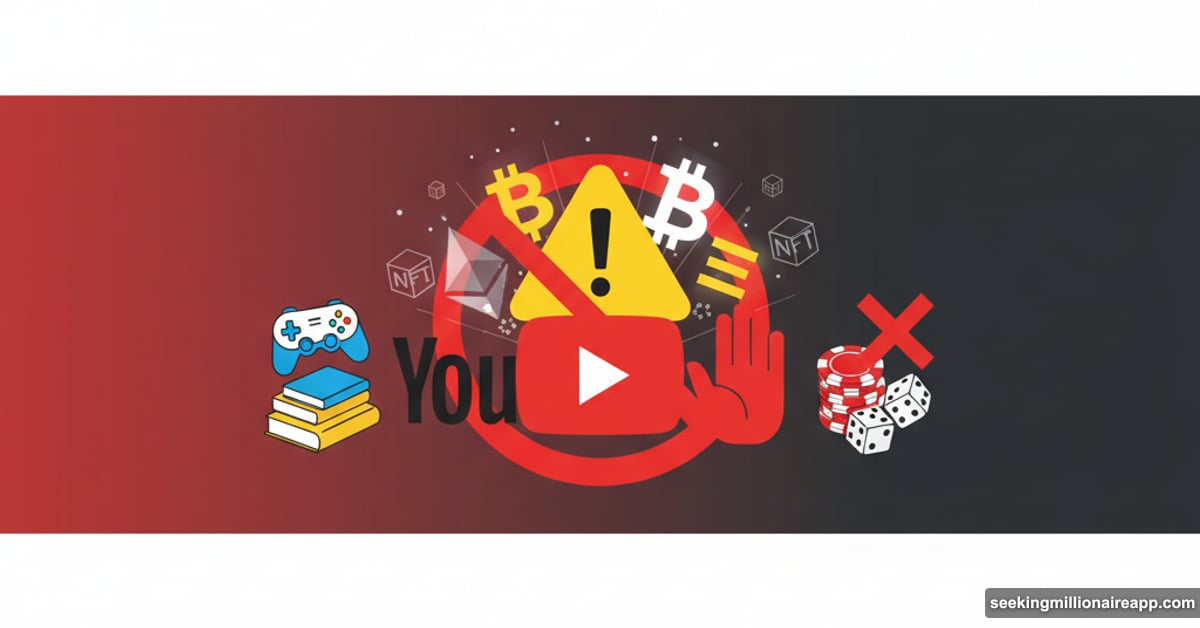YouTube just rewrote its gambling policy. Now crypto creators fear they’ll lose monetization on November 17, 2025.
The panic started fast. NFT YouTubers worried their channels would vanish overnight. Web3 gaming content seemed doomed. But after days of confusion, YouTube clarified what’s actually banned versus what’s still allowed.
Here’s what really happens when the new rules take effect.
The Rule That Sparked Panic
YouTube announced updated Community Guidelines on October 28, 2025. The new policy targets gambling content that promotes uncertified sites or apps.
But here’s the twist. The rules now cover gambling with digital goods. That includes video game skins, cosmetics, and NFTs.
That last part triggered alarm bells. NFT creators immediately assumed YouTube would classify all blockchain content as gambling. Given that gaming NFTs hit $4.8 billion in valuation during 2024, the stakes felt enormous.
Creator LeevaiNFT captured the mood perfectly. He posted on X that YouTube’s policy felt like “a direct attack on Web3 gaming.” His frustration resonated with thousands of creators who built audiences around crypto gaming content.
The core fear makes sense. If showing NFTs counts as promoting gambling, then most Web3 gaming channels would violate the new rules. That would kill monetization for an entire creator category.
What YouTube Actually Banned
After creator backlash, YouTube issued a clarification. Turns out the policy is narrower than people thought.
Showing NFTs or video game skins remains completely fine. Educational content about blockchain technology gets the green light too. Gameplay videos featuring digital assets won’t trigger violations.
So what crosses the line? Content that promotes casino-style gambling using digital goods. Specifically, videos directing viewers to third-party sites where they wager skins or NFTs in gambling-style games.

YouTube will also age-restrict social casino content, even when no real money changes hands. That targets simulated gambling that normalizes betting behaviors.
Moreover, videos uploaded before November 17, 2025 won’t result in channel strikes if they violate the new rules. YouTube will remove or age-restrict them, but creators get grace on old content. They can also use YouTube’s editing tools to fix videos before the deadline.
The distinction matters enormously. Educational NFT content? Safe. Gameplay showcasing blockchain items? Also safe. Telling viewers to bet NFTs on unregulated casino sites? That’s what gets banned.
Why Advertisers Forced This Change
Several creators argued that advertiser pressure drove the policy update, not genuine concern about crypto content.
Large brands increasingly demand brand safety. They don’t want their ads running alongside gambling-related videos. YouTube faces pressure to keep advertisers happy, which means stricter content controls.
One crypto YouTuber noted that disabling monetization would solve most problems. If a video doesn’t run ads, advertiser concerns disappear. But that approach kills revenue for creators who rely on YouTube income.
Meanwhile, Google’s system lets certified gambling operators run ads under region-specific rules. Some creators see a double standard. Legitimate gambling companies can advertise freely, but independent creators face harsh restrictions.
The UK government’s September 2025 review on skins gambling added regulatory pressure. Officials recommended oversight for in-game items with tradable real-world value. That created momentum for platforms to act preemptively.
Still, the advertiser angle explains why YouTube drew lines around certain content types. Brands want control over where their ads appear. Crypto gambling sits at the intersection of finance, gaming, and unregulated activity. That makes advertisers nervous.
The Real Impact on Web3 Creators
YouTube’s clarification helped, but uncertainty remains. Enforcement details matter more than policy language.

How will YouTube distinguish between “showing” NFTs and “promoting” them? If a creator discusses a new NFT collection’s features, does that count as promotion? What about affiliate links to NFT marketplaces?
These gray areas create risk. Creators who monetize Web3 content must now calculate whether YouTube’s rules are worth navigating. Some might shift to platforms like TikTok or focus on sponsorships instead of ad revenue.
LeevaiNFT acknowledged that legitimate crypto creators face unfair burdens. He questioned whether YouTube monetization justifies the added regulatory complexity. Other platforms might offer more flexibility without the gambling policy constraints.
Plus, content that remains allowed today could face restrictions tomorrow. Platforms regularly update policies as regulatory pressure increases. Crypto creators working in this space deal with constant uncertainty about what’s permitted.
The gaming NFT market expects 24.8% annual growth through 2034. That suggests enormous opportunity for creators. But opportunity means nothing if platforms keep changing the rules mid-game.
What Creators Should Do Now
Web3 content creators face a decision before November 17, 2025. Option one: adapt content to clearly comply with YouTube’s guidelines. Focus on education, gameplay, and technology discussions. Avoid any content that could be interpreted as promoting gambling.
Option two: diversify platforms. Don’t rely solely on YouTube for audience and revenue. Build presence on TikTok, Twitter, or decentralized video platforms. That reduces risk if YouTube tightens rules further.
Option three: disable monetization on borderline content. If a video might trigger the policy, turn off ads. You keep the video live without risking channel strikes.
The safest approach combines all three strategies. Produce clearly compliant content, grow audiences elsewhere, and selectively monetize. That protects against policy changes while maintaining revenue streams.
Yet this situation highlights a broader problem. Centralized platforms control creator livelihoods through policy updates. One announcement can jeopardize years of audience building. That’s why many crypto advocates push for decentralized alternatives.
YouTube’s gambling policy won’t kill Web3 content entirely. But it adds friction and uncertainty. Creators must now navigate vague enforcement standards while hoping YouTube doesn’t move the goalposts again.
The November 17 deadline approaches fast. Smart creators are already adjusting their content strategy. Those who wait risk losing monetization without warning.
